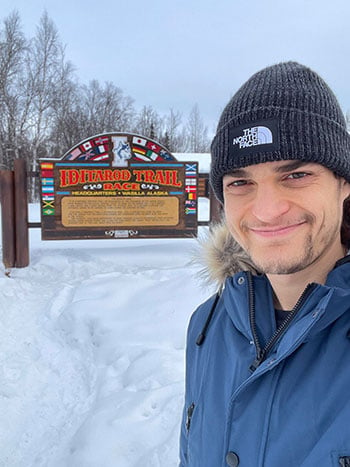The Iditarod Trail Sled Dog Race is an annual long-distance race, running through a rugged landscape of tundra and spruce forests, over mountain passes, across rivers, and over sea ice, held in Alaska in early March.
Mushers and a team of between 12 and 14 dogs cover 938 miles from Anchorage to Nome in 8–15 days or more. The Iditarod began in 1973 to test the best sled dog mushers and teams but evolved into today’s highly competitive race.
A famous event in 1925 known as the “Great Race of Mercy” inspired the modern-day race. A diphtheria epidemic threatened Nome and the nearest antitoxin was in Anchorage, nearly one thousand miles away. Twenty mushers and 100 dogs were deployed in a relay to get the serum to Nome.
The Iditarod relies on dozens of veterinarians, pilots, and other volunteers to care for the dogs and ensure the race goes smoothly.
Dr. Zac Pilossoph, a consulting veterinarian to Healthy Paws, volunteered to help care for dogs in the 2023 race. In honor of National Sled Dog Day (Feb. 2), we asked him about the experience.
How did you get interested in volunteering for the Iditarod?
A close veterinary friend recommended I volunteer for it a couple of years ago since she had been doing it for years, saying it was a very difficult but rewarding experience. I literally looked up nothing about it and applied on a whim, never expecting to be chosen. Surprisingly, I was chosen the first time around, so that is how my Iditarod story began!
What were your daily tasks; how does it work for vet volunteers?
The daily tasks were a bit different depending on the checkpoint you were assigned to. The primary responsibility of the veterinary team was to visually and, if deemed necessary, physically inspect the racing dogs each time they came through a checkpoint (checkpoints were about every 30-50 miles along the 1,000-mile trail). The mushers often would already be aware of a dog that needed examination or to be removed from the race. Sometimes, they would even take them off the lead line and put them in the sled with them!
Other times, the veterinarians would find something abnormal and need to do a more thorough exam. Overall, the mushers and veterinarians worked very well advocating for the dogs’ health and well-being during this challenging event. If we determined a dog was unfit to continue the race, we would provide medical care at the checkpoint and fly them back to Anchorage as soon as possible to continue their care there.
What did you learn about the dogs and how they are treated?
First, the sled dogs are some of the nicest and most friendly dogs I have ever met. I would have never guessed that this would be their demeanor. Usually, Nordic-breed dogs are a bit nervous and anxious, so this behavior surprised me.
Second, these dogs genuinely love what they do, and it is incredible to learn this first-hand. Even at checkpoints hundreds of miles into the race, they would pull at the ropes, wanting to continue, and were legitimately frustrated by being forced to stop. The athleticism and perseverance were just amazing.
Lastly, I felt like the mushers were very aware that they only had a chance at finishing the race if working with a healthy group. More often than not, the mushers would volunteer for a dog to be looked at or removed from the race for suspected health reasons.
What were the working conditions like? How cold was it?
The working conditions were undoubtedly the most challenging part. It was subject to the checkpoint you were assigned, but you had no idea what you were set out for. In a nutshell, we all start in Anchorage at a hotel, our checkpoint site. Then, throughout the race, we get flown out on tiny seaplanes across the entire state and set up the checkpoints by hand as the race progresses.
The temperatures outside fluctuated from 20 degrees F to -20 degrees F between day and night (and there were MANY nights that we were up throughout the whole time on shift waiting for teams to come through).
Regarding wilderness living conditions, some vet teams had to sleep in tents made for harsh winters for days. Others had to find space in cottages or rest stops owned or run by native Alaskans. I worked at two checkpoints, one a very tiny log cabin with two other people, the other a village with ten other people (both vets and non-vet volunteers), where we slept in the village’s common building on the floor. Although that sounds crazy, I was super fortunate to have lights and heat. Many other vets did not have those basic comforts we take for granted.
The one thing you don’t have once you start getting sent further and further out is hot water for showers or general consumption. We had to boil well water or fresh snowfall to get hot, non-contaminated water in these locations, which was a reality check for me. Nonetheless, the camaraderie, teamwork, and effort every person put in as a volunteer coming from all across the world was truly an unquantifiably rewarding experience. I am fortunate to have been invited back this year and cannot wait to gain more experience and stories.









